The first in a series of posts uncovering the history of the city block that the new Christchurch convention centre, Te Pae is being built on.
Te Pae, the new Christchurch convention centre is currently under construction and due to open in 2020.
At 28,000 square metres Te Pae is going to be a big, curvy beastie and most of the North West quadrant of Cathedral Square through to the Armagh-Colombo intersection has been cleared. The one lonely exception is Isaac House.
Te Pae, the name, has several te reo Māori references but in particular speaks to a meeting or gathering place. One of the buildings that stood on the current footprint of Te Pae was "The Rink", a roller skating rink, meeting venue and livery stable built in 1876.
"A very amusing place to go..."
Messrs Edward Waugh Millett and Saunder, “the spirited proprietors of the well-known livery stable” proposed a new-fangled skating rink close to their existing premises on Gloucester Street (I'm not sure what "spirited" suggests but I'm imagining mutton-chop whiskers, a twinkle-in-the-eye and maybe some barmaid bottom slapping).
At least one droll punter, in a letter to the editor, disagreed that a rink was necessary, pointing out that the East Belt (what we now call Bealey Avenue) provided much the same experience of a wintertime suggesting Millett and Saunder "could have the amusement they require in the most slippery form, without going to the expense of erecting a covered building".
Constructed by J. Goss, the building was a large hall 165 x 65 ft covering a quarter acre of ground from Gloucester through towards Armagh Street. The skating surface was asphalt with a spectator promenade on one side and the main entrance off Gloucester Street. The total cost of the building was some £2000. Patent roller skates called the Sylvester were supplied by Mr Burt of Dunedin.
The Rink opened in November 1876 and was an instant hit. The Lyttelton Times reported on 21 November that all available skates were in use and many patrons had to be turned away. A large number of non-skating spectators got “a good return for their money in the shape of entertainment..the repeated falls of the majority of the gentlemen on wheels were of a most laughable character” as was reported in The Press.
The Rink was opened to the public for three days a week and to club members for three days, and presumably closed on a Sunday. With gas lighting for night-time use, it had separate dressing-room facilities for the ladies.
Exhibition skating by Professor Taylor and Miss Lillie drew in a large crowd of some 2000 people in December 1876. The Lyttelton Times predicted that the Rink was set to be heavily patronised for the foreseeable future.
Well, yes and no, Lyttelton Times.
In 1878 the spirited Mr Millett decided to return to England and sold his lease with some 19 years still to run, plus horses, harnesses and plant. Saunders had already left the business and the skating rink would soon be converted to an extensive livery stable. While he raised a handsome sum of money, Edward Millett, better known as Tom, actually stayed on in Christchurch. Dying in 1886 he was much mourned as a familiar figure of the horsey set, always clad in hunting costume.
Sir George Grey, the New Zealand premier, spoke at the Rink on 9 September 1879. Crowded almost to capacity, the Rink held some 1800 to 2000 Christchurch citizens, Grey encouraged the Christchurch audience to enjoy their achievements, opens a new window thus far such as the Canterbury Museum and Canterbury College but the time had come for people of the Provincial Canterbury District to assert their rights against large landowners and demand small farms for all and homes for all. Stirring stuff.
From skates to stables
The Rink had passed into the hands of Frederick William Delamain in 1879 after a very brief tenure as Etherington & Co's Livery Stables. Yet another noted horsey dude, Delamain previously owned a racing stable he named Yaldhurst after his uncle's stables in England. In time this became the name of the district.
Delamain initially operated as an auctioneer, stock and land agent from the Gloucester Street site offering "large storage and good stabling", opens a new window
Later, livery and carriage and driver hire became the core business. Up to sixty horses could be comfortably stabled and numerous vehicles supplied including buggies, dog-carts, drays and with access to hansoms, landaus and four wheel cabs. A full-time harness maker was employed and host of expert drivers (strangely, there does seem to have been a lot of contemporary newspaper stories featuring vehicular collision and bolting horses in the Gloucester Street environs). The stables were connected to the telephone exchange (so modern, so convenient).
Frederick went bankrupt in 1892. He creatively cited "rabbits (and the low price of wool)" as contributory factors in his financial decline. Two of his creditors were his daughters who had lent him over £1,700 which in today's money stacks upwards of $340,000. Bad dad.
The Rink Stables went under the hammer in 1894 and the "lease and goodwill of the premises" were purchased by Mr William Hayward. William Hayward spent the 1860s transporting produce to the West Coast by wagon - not a task for the fainthearted. Later he worked the gold fields in Thames before running coaches in the North Island. Back in Canterbury he started a regular coach service between St Albans and the city, and later between Sumner and Christchurch.
By 1897 a horse drawn ambulance was stationed at The Rink. Later this became a motorised vehicle but even as late as 1911 there was confusion and debate over payment for ambulance services. St John's were clear that ambulances would be despatched on the basis of need regardless of payment, opens a new window.
With his son and trading as W. Hayward and Co, William enlarged the stables in 1898. The existing rink was extended 135 feet north and took up nearly the full extent of the block between Gloucester and Armagh Streets. Constructed of brick and corrugated iron the new addition included further horse stalls, loose boxes, an office, loft storage for feed, a harness room and space for vehicle storage and maintenance. There was also a "crush" , opens a new windowyard for breaking in horses, and most importantly and innovatively - a bicycle stand. Here 32 "machines" could be accommodated, secured with a padlock and with a key retained by the bicycle owner for the duration of the day.
A Hayward and Co canoe landau was used for the Duke and Duchess of Cornwall's royal tour of Christchurch in 1901. upholstered in finest Morocco and lined with dark blue cloth it was built in London. The Duke and Duchess became, in 1910, George V and Queen Mary.
Hayward and Co's bicycle innovation wasn't to be their last, the world was changing and big time.
William Hayward took a trip to the "Old World" in 1901 and reported back to the Lyttelton Times "that Christchurch should adopt, without delay, a scheme of electric lighting and traction." He was disappointed with the cars in New York but was impressed with the appearance of hackney horses in England. He also opined that "motor traffic did not seem to be making headway". So very wrong, William.
The coming of the motor-car
Later under a headline screaming THE MODERN MENACE, opens a new window William Hayward said he found motorists unsympathetic to drivers of horse drawn vehicles, and was strongly in favour of a speed limit (he suggested 10 to 12 miles an hour in the city and for a 3 mile radius).
If you can't beat them join them - later, in 1909 Hayward and Co had a dozen motorised taxicabs being shipped to Christchurch. A mixture of 2 and 4 seaters they could manage a top speed of 25 miles per hour. So successful were they that in 1913 they made space for their motorised fleet by selling off landaus, drags, charabancs, carts, gigs, horses, harnesses etc.
William Hayward Senior died at his home in the Cashmere Hills on 25 June 1917, and this was effectively the end of the Rink Stables. William Hayward Junior was running Rink Taxis Ltd and the closure of the stables was announced at the end of 1917. William Junior stated "The motor ambulances and motor-hearses have put the finishing touch on it", opens a new window
Rink Taxis Ltd continued to be a great success and "Ring the Rink" was a much used advertising slogan of the time. The taxi service operated from a number of different locations including Armagh Street and Victoria Square.
Department store era
In 1929 it was reported in The Press that a modern building was to be erected on the site of the old Rink Stables on Gloucester Street. A recently formed drapery business, Hays Ltd, was set to open.
And successfully open, opens a new window it did, their big "friendly store" in time ended up taking up a large part of the Colombo, Gloucester and Armagh streets block. It later became Hay's, fondly remembered for its rooftop playground, "Aunt Haysl" and the annual Christmas parade. And after a few more name changes, the store became the institution we now know as Farmers.


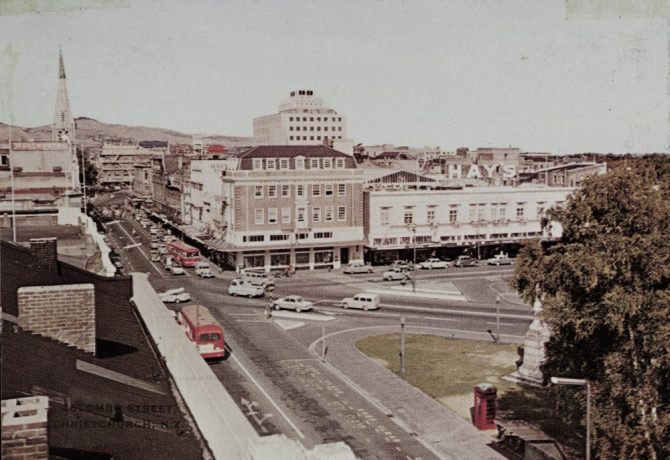

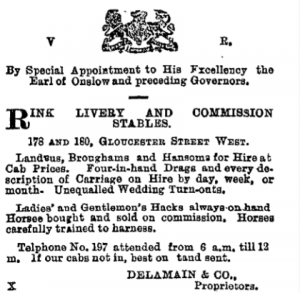
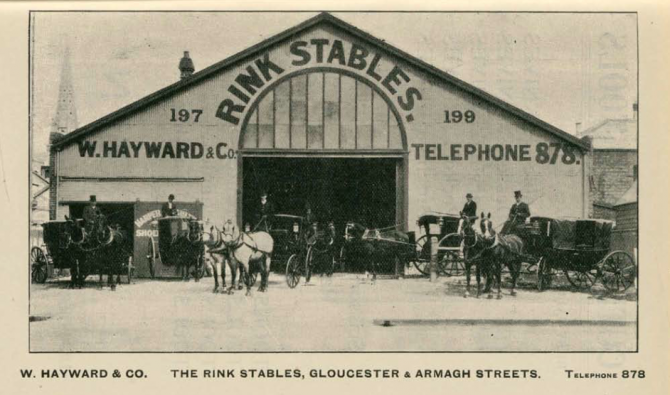
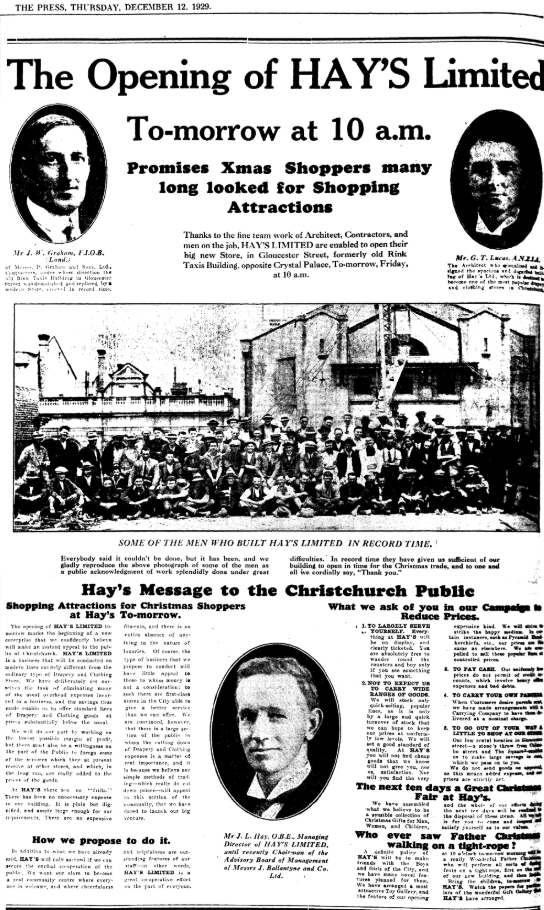
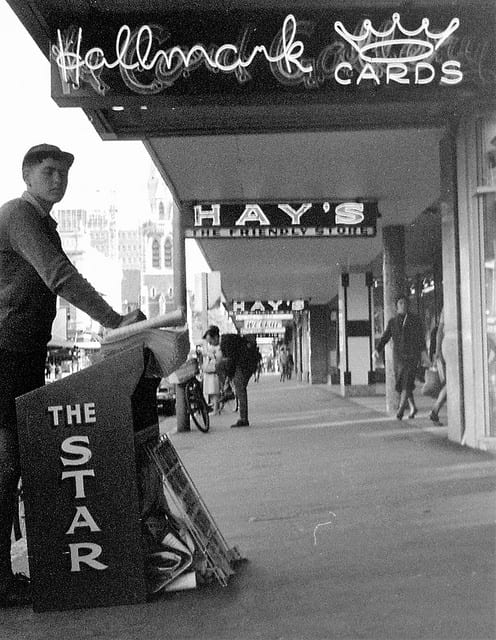

Add a comment to: Goodbye Gloucester Street West: The Rink Stables